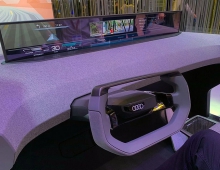
China's Allwinner Develops UltraOcta A80 processor
Chinese fabless design company Allwinner Technology today unveiled its next-generation UltraOcta A80 processor, an octa-core heterogeneous SoC design that includes a PowerVR Series6 GPU by Imagination Technologies.
Allwinner says their UltraOcta processor is designed to bring "premium performance devices to consumers at lower price points." Devices include tablets, OTT media players, notebook PCs, all-in-ones, and even smart TVs.
Keeping power consumption to a minimum has been a key focus for Allwinner's new UltraOcta A80. With CoolFlex, Allwinner claims its UltraOcta enables maximum performance for applications while keeping overall power consumption low.
The 64-core PowerVR G6230 GPU from Imagination Technologies sits at the heart of the SoC, powering 3D gaming, high-resolution graphical UIs and web browsing at fast speeds.
The G6230 graphics core incorporates PVR3C, a portfolio of compression technologies designed to work together to deliver high SoC performance while achieving power savings. PVR3C includes:
- PVRTC and PVRTC2 texture compression formats
- PVRIC (lossless image compression)
- PVRGC (lossless geometry compression): reduces overall
bandwidth usage and related system costs
The PowerVR Series6 Rogue cores include Unified Scalable Clusters (or USCs); each cluster contains 16 pipelines and each pipeline has 2 FP32 ALUs. The PowerVR G6230 GPU is a dual-cluster design that has a total of 64 FP32 ALU cores. Additionally, the PowerVR G6230 GPU includes a number of FP16 cores which provide additional low-power performance for a range of graphics applications, including fast blending for HDR rendering in games and UIs.
Scalar processing achieves the highest utilization of ALUs and eases graphics programming. Whereas vector arithmetic units occupy more silicon than a scalar unit and might not be fully used if code is not operating on vectors, scalar ALUs handle algorithms written with scalar ops (R), vec2 ops (RG), vec3 (RGB) or a full vec4 (RGBA) with the same efficiency. In addition, scalar instructions decrease the complexity of the instruction set, requiring less chip area for the instruction decoder.
The efficiency of Rogue GPUs is derived from its tiling-based deferred architecture (TBDR) combined with a unified shader approach to the programmable elements of the GPU.
Thanks to the Rogue architecture on which PowerVR G6230 is based on, the Allwinner A80 processor is able to support all major mobile and desktop APIs, including OpenGL ES Next/3.0/2.0, OpenGL 3.x, DirectX 9_3/10, OpenCL and Renderscript.
Keeping power consumption to a minimum has been a key focus for Allwinner's new UltraOcta A80. With CoolFlex, Allwinner claims its UltraOcta enables maximum performance for applications while keeping overall power consumption low.
The 64-core PowerVR G6230 GPU from Imagination Technologies sits at the heart of the SoC, powering 3D gaming, high-resolution graphical UIs and web browsing at fast speeds.
The G6230 graphics core incorporates PVR3C, a portfolio of compression technologies designed to work together to deliver high SoC performance while achieving power savings. PVR3C includes:
- PVRTC and PVRTC2 texture compression formats
- PVRIC (lossless image compression)
- PVRGC (lossless geometry compression): reduces overall
bandwidth usage and related system costs
The PowerVR Series6 Rogue cores include Unified Scalable Clusters (or USCs); each cluster contains 16 pipelines and each pipeline has 2 FP32 ALUs. The PowerVR G6230 GPU is a dual-cluster design that has a total of 64 FP32 ALU cores. Additionally, the PowerVR G6230 GPU includes a number of FP16 cores which provide additional low-power performance for a range of graphics applications, including fast blending for HDR rendering in games and UIs.
Scalar processing achieves the highest utilization of ALUs and eases graphics programming. Whereas vector arithmetic units occupy more silicon than a scalar unit and might not be fully used if code is not operating on vectors, scalar ALUs handle algorithms written with scalar ops (R), vec2 ops (RG), vec3 (RGB) or a full vec4 (RGBA) with the same efficiency. In addition, scalar instructions decrease the complexity of the instruction set, requiring less chip area for the instruction decoder.
The efficiency of Rogue GPUs is derived from its tiling-based deferred architecture (TBDR) combined with a unified shader approach to the programmable elements of the GPU.
Thanks to the Rogue architecture on which PowerVR G6230 is based on, the Allwinner A80 processor is able to support all major mobile and desktop APIs, including OpenGL ES Next/3.0/2.0, OpenGL 3.x, DirectX 9_3/10, OpenCL and Renderscript.





















